Plunge pools are made from a variety of materials, each with distinct features. Traditional favorites include durable stone, low-maintenance stainless steel, and affordable vinyl. Concrete, another popular choice, is valued for its versatility in design and durability, while fiberglass offers benefits like algae resistance and quick installation. If you're thinking green, consider natural options like bamboo pools with their superior thermal insulation. Your final choice should factor in aspects like aesthetics, maintenance requirements, and local climate conditions. By exploring these materials in-depth, you'll get a better understanding of what suits your situation best.
Understanding Plunge Pool Materials
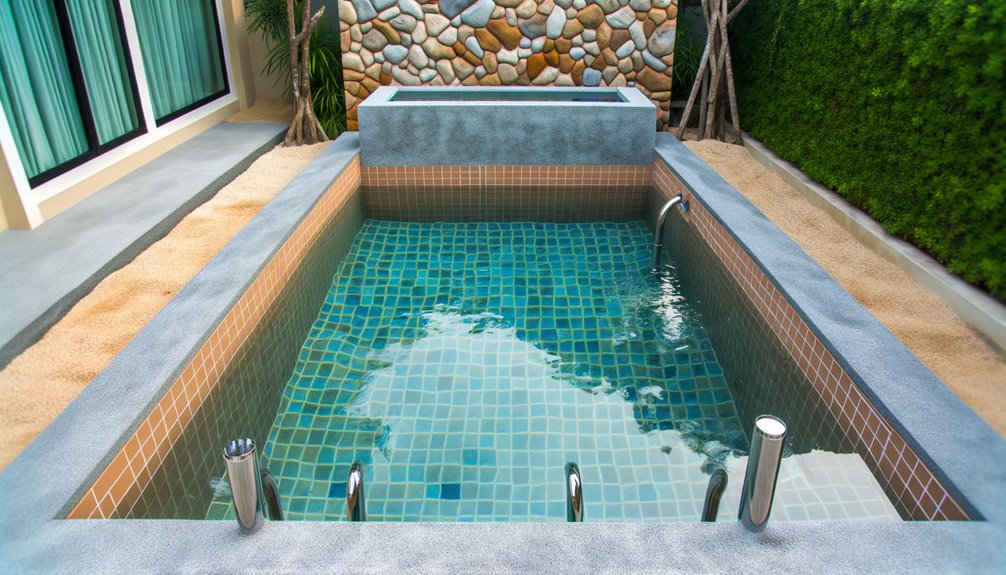
While choosing the right materials is essential when constructing a plunge pool, understanding what these materials are and their unique properties can seem intimidating.
But don't worry, you're not alone in this. Different plunge pool designs demand varied material comparisons. You've got traditional stone, sleek stainless steel, and versatile vinyl to evaluate.
Stone, though sturdy and naturally beautiful, can be costly and require regular maintenance.
Stainless steel is a modern choice, offering durability and a contemporary aesthetic. It's also resistant to harsh chemicals and temperature changes.
Vinyl, being less expensive and flexible, is a favorite among DIY enthusiasts. However, it's prone to damage over time.
Understanding these material comparisons and their impact on plunge pool designs is key to making an informed decision.
Concrete Plunge Pool Basics
You've already explored the properties of stone, stainless steel, and vinyl regarding plunge pool construction.
Now, let's explore concrete types and pool designs. Concrete is a popular choice for plunge pools due to its immense versatility and durability. You can mold it into any shape or size, fitting perfectly into your environment. From classic rectangular to freeform designs, concrete lets you get creative.
There are primarily two types: shotcrete and gunite. Shotcrete is a wet mix concrete applied through a hose, known for its strength and affordability. Meanwhile, gunite is a dry mix sprayed with water at the nozzle, providing superior adhesion and strength.
To summarize, concrete's flexibility and strength make it a standout choice for plunge pools.
Fiberglass: A Popular Choice
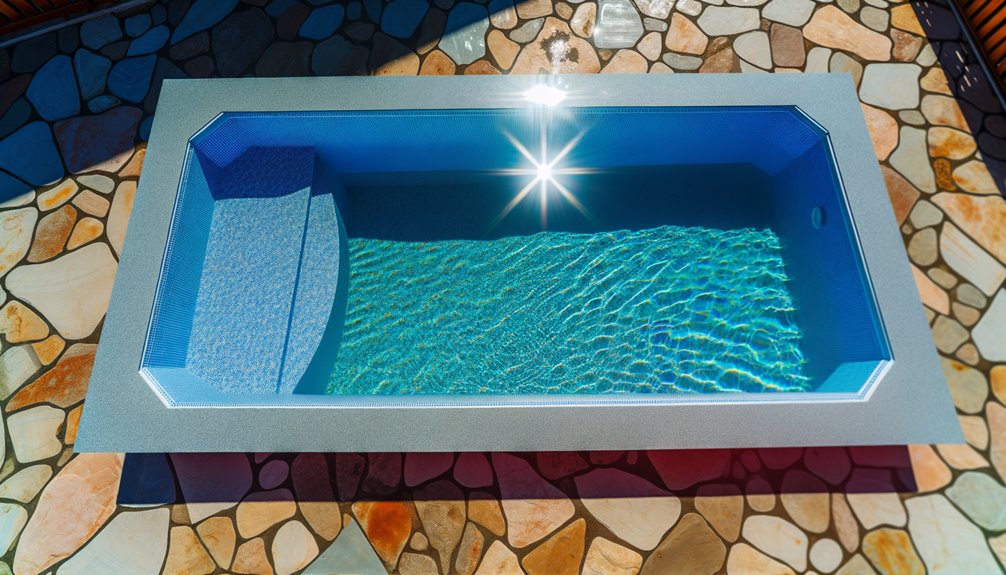
Now let's turn to fiberglass, a popular choice for plunge pools.
We'll explore the benefits of fiberglass pools, walk you through the installation process, and give you some tips on maintenance.
Fiberglass Plunge Pool Benefits
Three key benefits make fiberglass a popular choice for plunge pools.
To begin with, fiberglass boasts a smooth, nonporous surface that's not just comfortable but also inhibits algae growth, reducing your cleaning time. This is one of the standout fiberglass advantages.
Moreover, fiberglass plunge pools offer remarkable longevity. Unlike concrete, fiberglass doesn't crack or chip easily, ensuring your pool stays in pristine condition for years.
Plus, its color doesn't fade rapidly, maintaining the pool's aesthetic appeal longer.
Lastly, fiberglass pools are energy-efficient. Their insulating properties help maintain water temperature, reducing your heating costs.
They also require less chemical use than other pool types, making them an eco-friendly choice.
Installation Process Explained
Although fiberglass plunge pools may seem intimidating to install, rest assured that the process is fairly straightforward and manageable.
First, pool preparation is essential. The ground needs to be stable and level, so excavation might be necessary. Once the site is prepared, the pool shell is lowered into the hole using a crane.
Various installation techniques are then employed. The shell is checked for level, then filled with water while backfilling with sand or gravel to stabilize it. The plumbing is hooked up and tested for leaks.
Finally, the pool deck is installed. This entire process can usually be completed in just a few days.
It's important to remember that professional installation guarantees the best results and longevity for your fiberglass plunge pool.
Maintaining Fiberglass Pools
After setting up your fiberglass plunge pool, it's important to focus on regular maintenance to guarantee it stays in peak condition.
Fiberglass care is straightforward but requires consistency. One of your primary tasks will be maintaining water chemistry, which involves monitoring pH levels, alkalinity, and sanitizer levels. These are essential to prevent algae growth and staining.
Routine inspections are also critical in fiberglass care. Look for signs of wear and tear, such as cracks or blisters in the pool's surface. If detected early, these minor issues can be corrected without major repairs.
Don't forget to clean the pool filters regularly, and skim debris from the pool surface daily to maintain its aesthetic appeal.
Proper maintenance will prolong your pool's lifespan and guarantee that it remains a relaxing retreat for years to come.
Vinyl Lined Pool Considerations
As you consider the options for plunge pool materials, it's essential to examine vinyl lined pools.
This material offers distinct benefits, which we'll outline, but also requires specific maintenance considerations.
Let's shift our focus to the aspects of vinyl lined pools, their advantages, and the care they demand for peak functionality.
Benefits of Vinyl Lining
While you might be weighing various materials for your plunge pool, vinyl lining emerges as a strong contender due to its numerous advantages.
The benefits of vinyl can be broken down into four main categories:
- Vinyl Longevity: Vinyl liners generally last for about ten years, providing you with a decade of worry-free pool enjoyment.
- Vinyl Aesthetics: With a wide range of colours and patterns, vinyl liners enhance the visual appeal of your pool.
- Cost-Effectiveness: Vinyl liners are cheaper than other materials like concrete or fiberglass, making them a budget-friendly option.
- Comfort: The soft texture of vinyl is gentle on your skin, ensuring a more comfortable swimming experience.
These benefits make vinyl lining a worthwhile option to evaluate for your plunge pool.
Maintenance for Vinyl Pools
Though vinyl-lined pools offer numerous benefits, it's essential to understand their maintenance needs to guarantee their longevity.
Regular vinyl care is key. Unlike concrete or fiberglass, vinyl is prone to tears and leaks, so be vigilant for any signs of damage.
Keep the pool clean; debris can cause discoloration and wear. A pool cover can protect the vinyl from direct sunlight, which can lead to fading.
Chemical balance is also important; incorrect levels can degrade the vinyl. Maintain a consistent water level to prevent stretching or shrinkage.
Finally, avoid draining the pool completely as this can cause the liner to shrink or wrinkle.
With proper maintenance, you'll guarantee your pool's longevity and enjoyment for years.
Natural Stone Plunge Pools
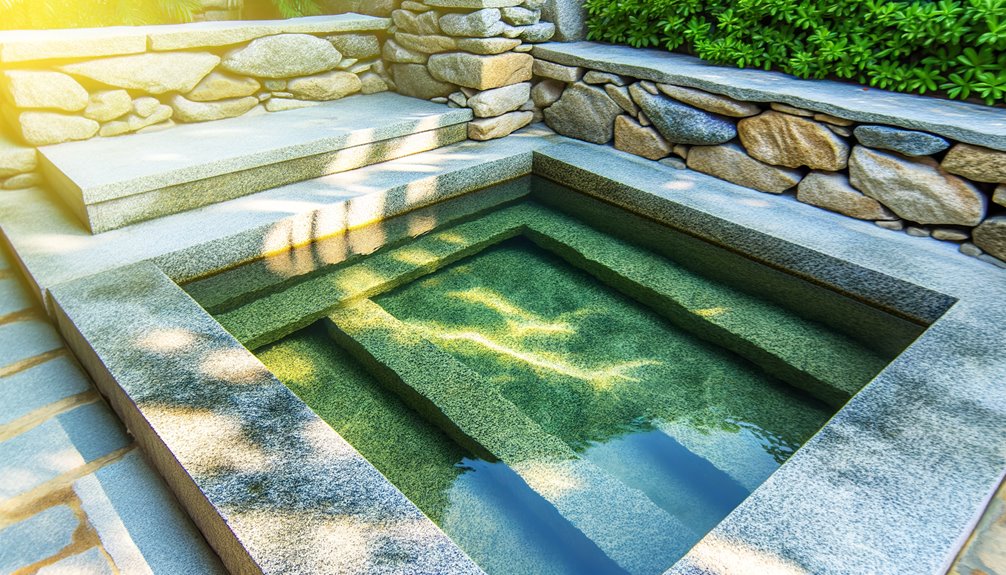
If you're seeking a unique and enchanting aesthetic for your plunge pool, natural stone stands as a top choice. The beauty of these pools lies in the myriad of natural stone options available, and each one brings a distinct aesthetic appeal.
Natural stone plunge pools offer:
- A wide range of color and texture options
- A sturdy and durable structure
- An eco-friendly choice
- A timeless and luxurious appeal
Granite, limestone, and travertine are just a few of the stone options you can choose from. Each stone has unique qualities that contribute to its charm.
Natural stone plunge pools not just look stunning, they also blend harmoniously with outdoor surroundings, creating a serene retreat in your backyard.
Ceramic Pools: Pros and Cons
Ever thought about a ceramic plunge pool? They're admired for their ceramic durability and aesthetics.
These pools are renowned for withstanding harsh weather conditions, making them a reliable choice. Their smooth, glossy surface not just exudes elegance but is also easy to clean. You'll appreciate the effortless maintenance and timeless appeal it provides.
However, there's a flip side. Ceramic pools might crack if the ground shifts, causing costly repairs.
Also, their installation requires more time and expertise compared to other materials. Finally, while their aesthetics are appealing, you're limited in customization options.
Exploring Stainless Steel Pools
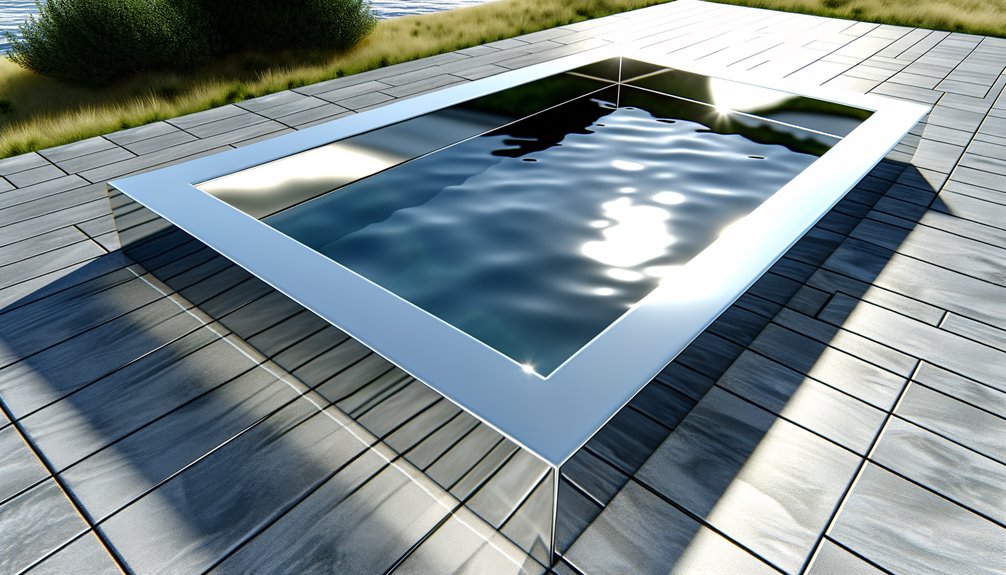
While ceramic plunge pools might've their charm, you may find stainless steel pools to be an attractive alternative.
These pools showcase the stainless steel aesthetics, with their sleek, modern look and reflective surface. But it's not just about looks. The stainless steel longevity means your pool will stand the test of time, resisting rust and corrosion.
Here are some key benefits to take into account:
- Durability: Stainless steel's strength guarantees your pool's longevity.
- Low Maintenance: They require less upkeep compared to other materials.
- Thermal Efficiency: Stainless steel retains heat well, saving energy costs.
- Versatility: Their design can be customized to fit your specific needs.
Eco-friendly Bamboo Plunge Pools
Though you may not have considered it before, bamboo plunge pools offer a unique and eco-friendly alternative to traditional materials. Known for its rapid growth and bamboo sustainability, this natural resource makes a compelling choice for pool construction.
Bamboo plunge pools utilize the natural strength and durability of bamboo, providing an eco-friendly design that's both innovative and aesthetically pleasing. They're a genuine demonstration of the potential of sustainable design.
You'll appreciate the lower carbon footprint and the seamless integration with your backyard environment. Plus, the natural insulation properties of bamboo can help maintain your pool's temperature, saving energy.
The Durability of Acrylic Pools
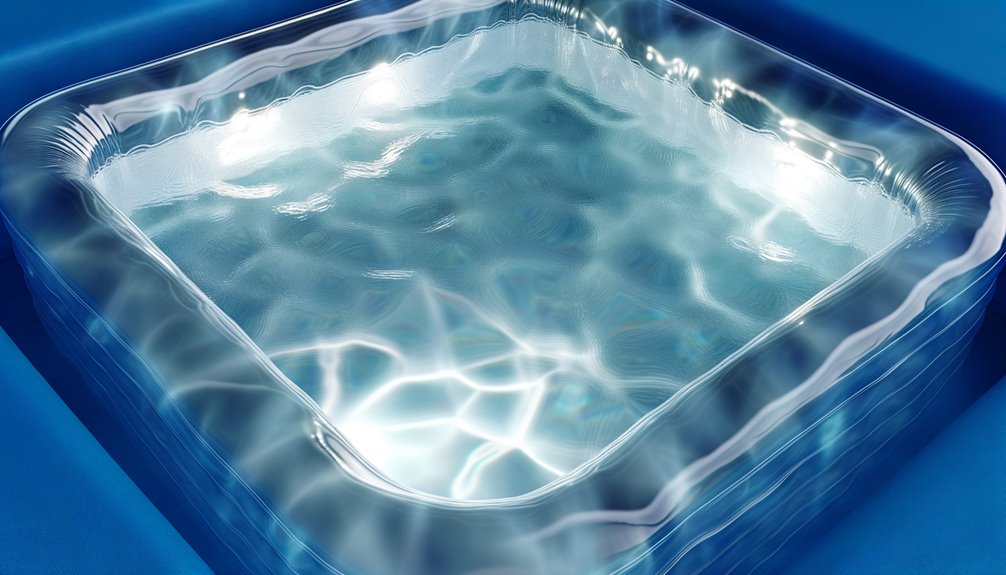
If you're looking for a material noted for its longevity and strength, consider acrylic for your plunge pool. Acrylic's strength is a standout benefit, promising endurance and resilience against wear and tear.
On top of that, the maintenance of acrylic pools is relatively easy. You'll find the cleaning process simple and the material resistant to staining.
To add depth, here are some key points about acrylic pools:
- Acrylic strength makes it resistant to cracking and damage.
- It offers a smooth and non-porous surface, reducing algae growth.
- The maintenance of acrylic pools is largely hassle-free.
- Its high durability guarantees a long lifespan for your plunge pool.
Opting for acrylic can provide you with a long-lasting, low-maintenance plunge pool.
Factors Affecting Material Choice
Having explored the durability of acrylic pools, it's worth considering the various factors that could influence your choice of material for your plunge pool. The right material can enhance your pool's longevity, ensuring you enjoy your investment for years to come.
The table below outlines key factors you should consider:
| Factor | Description |
|---|---|
| Material Durability | Consider how long the material lasts under regular use and weather conditions. |
| Cost Considerations | Your budget will greatly influence your material choice. Higher upfront costs might mean lower maintenance costs down the line. |
| Aesthetics | The material should complement your property's overall style. |
| Maintenance | Some materials require more upkeep than others. Consider the time, effort, and cost associated with maintaining your pool. |
These factors will help guide your decision, ensuring your pool is a valuable addition to your property.
Frequently Asked Questions
What Is the Typical Cost of Installing a Plunge Pool?
You're probably curious about the cost of installing a plunge pool.
It's a good idea to prepare an installation budget. Typically, prices can range from $20,000 to $25,000. This cost breakdown includes excavation, pool shell, filtration equipment, and labor.
However, prices can fluctuate based on location, materials, and any additional features you choose.
It's a significant investment, but it's worth it for the luxury and convenience of having your own pool.
How Long Does It Take to Construct a Plunge Pool?
You're curious about the construction timeline for a plunge pool? It's no small feat, and project planning plays a huge role.
Typically, it takes between 4-6 weeks to build a plunge pool. This includes excavation, construction, plumbing, and finishing touches.
However, factors like weather and permit approval can prolong this timeline. Consequently, it's always wise to plan ahead and have a buffer in your schedule for unexpected delays.
What Maintenance Is Required for Different Plunge Pool Materials?
Different plunge pool materials require varying maintenance.
For concrete pools, you'll need to brush the sides regularly to prevent algae growth.
Fiberglass pools, on the other hand, are easier to clean due to their smooth surface.
If you've a stainless steel pool, watch out for possible corrosion.
Always compare material maintenance requirements to find the best fit for you.
Are There Any Health Benefits Associated With Plunge Pools?
Absolutely, plunge pools offer significant health benefits.
By using one, you're treating yourself to relaxation benefits and temperature therapy. Dipping into the cool water can help reduce muscle inflammation after a strenuous workout.
Similarly, the warm water can soothe stiff joints.
In addition, the tranquil environment of a plunge pool can help ease stress and promote mental wellbeing.
How Do Weather Conditions Affect the Choice of Plunge Pool Materials?
Weather conditions greatly influence your choice of plunge pool materials.
In areas with harsh climates, you'll need materials with high durability to withstand extreme temperatures and weather patterns. For instance, concrete and stone are excellent options for cold climates due to their ability to resist frost damage.
Conversely, in hot, sunny locales, you'd want materials that won't fade or warp, like fiberglass.
It's all about matching material durability to climate considerations.
